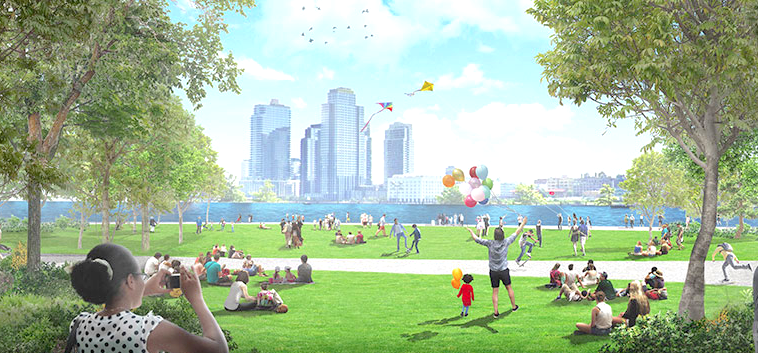Lower East Side ‘Resiliency’ Plan Hits New Potholes
More demands for an independent review of proposal that digs up a park and endangers cyclists while sparing a highway.

Lower East Side elected officials are joining local residents and the Manhattan Borough President Gale Brewer in demanding an independent review for a controversial, $1.45-billion city project to raise the Lower East Side’s coastline in order to protect it from climate-change-related storm surges.
State Senator Brad Hoylman, Assembly Member Harvey Epstein, and Reps. Nydia Velazquez and Carolyn Maloney are urging that the city appoint a panel of experts to review the East Side Coastal Resiliency Project, which would dig up the East River Park for almost four years and dislocate thousands of bike commuters who use its greenway bike route — all while sparing the adjacent FDR Drive during construction.
Epstein told Streetsblog that the city must ensure that its plan includes “viable and safe alternatives for everyone” because the park — in addition to providing vital greenspace in a crowded neighborhood — “serves as an important route for many New Yorkers that bike.”
That view was seconded by representatives of the cycling community.
“The city is treating the FDR Drive as this sacred thing and leaving it untouched, while closing the park and treating it as disposable, when for residents the park is sacred. Its priorities are out of whack,” Tom DeVito, the senior director of advocacy for Transportation Alternatives, told Streetsblog. “It unacceptable to shut down the park and divert thousands of bike commuters without any reasonable alternatives.”
DeVito added that the city’s suggested alternative routes of First and Second Avenues are “too far away” for the displaced bike commuters.
Sophie Maerowitz, a safe-streets activist who lives at 14th Street and Avenue C and uses the greenway to get to work, said that she is “incredibly concerned about how the plan will affect the East Side’s access to green space overall, but as a bike commuter down East River park daily, I’m especially upset about losing my daily car-free ride.”
“I’m going to be faced with an unprotected route to work after a year that has proved deadly for cyclists,” added Maerowitz, referring to the 15 cyclists who have been killed in traffic violence so far this year, up from 10 who died all of last year.
According to the Department of Transportation, the greenway carried 2,077 cyclists on weekdays and 1,974 cyclists on weekends during daylight hours in 2018, numbers that were expected to rise by 5 percent annually.
Others evoked the specter of boondoggle projects of yore in arguing for an independent review.
“We don’t want a ‘Big Dig’ and we don’t want another Westway,” Hoylman said at a public hearing on the project on July 17 convened by Brewer.
Hoylman was referring to a Boston Harbor tunnel project that went way overtime and over-budget, and an environmentally destructive 1970s plan to extend the West Side Highway, which failed in federal court. “We have a lot of questions, and we don’t have a lot of answers,” Hoylman said, pleading for an “independent, community-based monitor” for the East Side project.
The demand for review may gain the support of the Manhattan Borough Board, which will vote on the resiliency plan on Tuesday as part of the city’s Uniform Land Use Review Procedure.
Even if the plan passes the land-use review processes, the hearing at Mount Sinai-Beth Israel Medical Center showed that its introduction is proving to be a public-relations disaster for the de Blasio administration. Two administration officials who presented an update on the proposal at the hearing — Jamie Torres Springer of the Department of Design and Construction, and Alyssa Cobb Konon of the Parks Department — sat stone-faced as dozens of residents condemned the plan and demanded that the city keep open sections of the park during construction. No one from the community spoke in favor of the plan.
Torres Springer drew shouts of “Boo!” and “No!” from the packed hall when he announced that the city had rejected Brewer’s bid to extend review of the plan by two months and would instead only hold open the public-comment period by two weeks. “Sixty days! Sixty days!” the crowd chanted angrily.

Residents who packed the hearing complained that the plan replaces one that would have added acreage to the park by decking over the FDR — identifying the six-lane behemoth as a hated symbol of the very climate change the plan is supposed to ameliorate. Indeed, cheers greeted comments by resident Howard Brandstein, who proposed to rid the FDR of cars by devoting several lanes to electric buses. Residents also worried about the effects on health, the environment, and emergency preparedness posed by the long construction. And the greenway bike path was never far from mind.
“The city seems to have forgotten that there are more than one kind of cyclist,” resident Clara Weiss said, disapproving of the scheme because its proposed bike route seemed tailored only for abled cyclists and “would be right next to the FDR, with all its polluting fumes.”
The demand for an independent review comes in the wake of a request by Hoylman, Epstein, Maloney and Velazquez that the city study ways to install life-saving protected bike lanes on Avenues A, B, C, or D in order to serve the cyclists displaced from the greenway.





